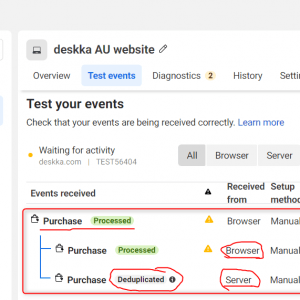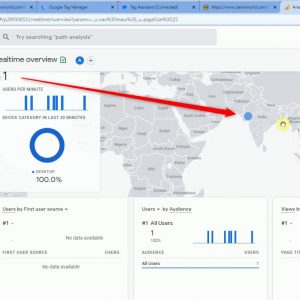Table of Contents
- 1 Introduction to Conversion Tracking
- 2 Strategies for tracking conversions:
- 3 Best Practices for Effective Conversion Tracking
- 4 Setting Conversion Goals
- 5 Setting up analytics platforms:
- 6 Tracking and optimization:
- 7 Challenges and Considerations:
- 8 Choosing the appropriate conversion metrics.
- 9 Attribution models:
- 10 Implementing Conversion Tracking Tags.
- 11 Attribution and Conversion Paths
- 12 Conclusion
- 13 Analyze Conversion Data
- 14 Attribution Models and Their Impact
- 15 Conversion Optimization Strategies
- 16 Advanced Conversion Tracking Techniques.
- 17 Best Practices and Pitfalls to Avoid
- 18 Conclusion
- 19 My Portfolio:
- 20 I am also available here!
Analytics focuses on discovering correlations and trends in data, whereas optimization focuses on cause and effect. However, combining analytics and optimization can be quite beneficial to your organization. So let’s look at real-world examples of how to use analytics better to drive testing results. We will divide it into four major parts:
- Introduction to Conversion Tracking
- Setting Up Conversion Goals
- Choosing the Right Conversion Metrics
- Implementing Conversion Tracking Tags
- Analyzing Conversion Data
- Attribution Models and Their Impact
- Conversion Optimization Strategies
- Advanced Conversion Tracking Techniques
- Best Practices and Pitfalls to Avoid
Introduction to Conversion Tracking
The most critical component of a digital marketing plan is conversion tracking. It lets businesses track and analyze user interactions, better understand client behavior, and tailor campaigns to get better results. In this section, we’ll go over the specifics of conversion tracking, such as its importance, methodology, and best practices. There are mainly two types of tracking that you can implement on your website, namely Client side and server side.
Why Conversion Tracking Matters:
- Understanding User Behavior:
Conversion monitoring gives information about how users interact with your website or application. Tracking specific actions (such as form submissions, purchases, or sign-ups) provides a better picture of user intent.
- Measuring Success:
Without conversion monitoring, you cannot assess the efficiency of your marketing activities. Are your ads creating actual conversions or just clicks? This question can be answered by conversion tracking.
- Campaign Optimization:
Marketing professionals can fine-tune their campaigns using conversion statistics. For example, dedicate more funding to an ad group with a high conversion rate. If another group isn’t performing well, change your plan accordingly.

Strategies for tracking conversions:
- Pixel Tracking:
Add a tracking pixel (a small bit of code) to your page. When a user performs a desired action (for example, completes a purchase), the pixel fires, documenting the transaction.
For example, Facebook’s pixel enables advertisers to follow user interactions throughout their websites and retarget them with suitable adverts. Facebook Conversion API is a much better tracking technique than Facebook pixel tracking that any business should implement to get data accuracy.
- Event Tracking:
Rather than tracking entire sites, focus on specific events (for example, button clicks and video views). Event tracking gives granular information.
For example, an e-commerce site may track eCommerce transactions like “Add to Cart” clicks and “Checkout” completions.
- UTM Parameters:
Use UTM parameters in your URLs. These tags assist in identifying the source of traffic as well as individual campaigns.
For example: ‘utm_source=google&utm_medium=cpc&utm_campaign=spring_sale’.
- Phone Call Tracking:
For firms that rely on phone inquiries, utilize different phone numbers for each campaign. Call tracking services collect call data.
For example, a real estate business may allocate various phone numbers to billboards, internet marketing, and social media posts. They can setup GA4 Custom Conversion Tracking on their website to track call click events.
Is Conversion Tracking properly setup on your website? Get a Free Audit.
Best Practices for Effective Conversion Tracking
- Set Clear goals:
Define what makes a convert in your business. Is it a sale, lead, or download? Align the tracking properly.
- Test and Iterate:
Continuously evaluate various tracking systems. A/B test landing pages, ad creatives, and tracking pixels to improve performance.
- Attribution Models:
Understand how different touchpoints influence conversions. The first-click, last-click, and linear attribution models offer different perspectives.
- Cross-Device Tracking:
Users interact with brands on several devices. Implement cross-device tracking to capture the entire consumer journey.
- Privacy Compliance:
Ensure compliance with data privacy regulations (such as GDPR and CCPA). Maintain transparency in the tracking procedures.
To summarize, setting up conversion tracking in GA4, or Google Ads, or Facebook for conversion monitoring enables marketers to make data-driven decisions, improve user experiences, and increase ROI. Understanding conversion metrics is critical for success in paid advertising, email campaigns, and organic SEO initiatives. Remember that business growth is driven by conversions, not just clicks.

Setting Conversion Goals
Understanding the Conversion Goals:
What are the conversion goals?
Conversion goals are particular activities that we want users to do on our website or application. These actions could include making a purchase, subscribing to a newsletter, downloading an e-book, or submitting a contact form.
Why Are They Important?
Conversion targets provide a clear direction for our marketing activities. Without well-defined goals, we’re navigating without a compass, unclear if we’re heading in the correct direction.
Types of Conversion Goals:
- Macro Goals:
These are the main objectives, such as closing a deal or creating a lead.
- Micro Goals:
Smaller actions help with the overall user experience, such as watching a video or adding things to the cart.
- Soft Goals:
Actions that demonstrate involvement or interest, such as staying on a page or clicking through several parts,.
- Hard Goals:
Specific outcomes, such as a completed purchase or form submission,.
Consider an e-commerce site. Their macro goal is to increase sales, while their micro goals include adding items to the cart and browsing product information.
Setting Conversion Goals:
- Defining KPIs:
Begin by defining key performance indicators (KPIs) that are relevant to your business objectives. These KPIs will help you achieve your conversion targets.

Setting up analytics platforms:
- Google Analytics:
Set up a new target in your GA4 account. Configure the kind (destination, length, pages/screens per session, or event) and the conditions.
- Facebook Pixel:
Create unique conversions for specific events (such as “Add to Cart” or “Lead Submission”).
For example, a travel agency may set a goal of having users spend at least 3 minutes on their “Tour Packages” page.
- Attribution Models:
Consider how you’ll assign conversions to various touchpoints (first-click, last-click, linear, and so on). This affects goal configuration.
- Testing and validation:
Thoroughly test your goals before deploying them. Ensure that they trigger correctly and correspond to user behavior.
Tracking and optimization:
- Progress Monitoring:
Review your conversion data regularly. Check for patterns, seasonality, and anomalies.
- Segment your data:
Segment your data based on traffic source, device, location, or user demographics. Understand which channels result in the most valuable conversions.
- A/B Testing:
Test out different landing pages, CTAs, and ad creatives. Optimize performance.
For example, an app developer might discover that users leave the payment process. They can then streamline the checkout procedure.
Challenges and Considerations:
- Cross-Device Tracking:
Users interact with brands on several devices. Make sure your conversion tracking accounts for this.
- Multi-Channel Attribution:
Understand how different channels affect conversions. Avoid oversimplification.
- Privacy Regulations:
Follow GDPR, CCPA, and other privacy regulations. Balance tracking and user privacy.
For example, a fashion store must comply with privacy standards while measuring conversions from its website, app, and social media marketing.
In summary, establishing conversion targets requires a deliberate combination of technical configuration, data analysis, and optimization. By understanding this approach, marketers can direct their campaigns to success using a compass of well-defined goals. Remember that it’s not only about reaching targets; it’s also about understanding user behavior and designing meaningful experiences that drive conversions.
Facing any issues in setting up Conversion Tracking on your website?

Choosing the appropriate conversion metrics.
- Understanding the Use of Conversion Metrics:
Conversion metrics act as the compass that directs your marketing approach. Before selecting precise metrics, it is critical to define your goals. Are you seeking to improve sales, sign-ups, or user engagement? Each aim necessitates distinct measures. For example:
- E-commerce Sales:
If you have an online business, you must track Google Ads conversion metrics or GA4 Analytics to get insight into revenue per visitor, average order value, and conversion rate (the percentage of visitors who make a purchase).
- Lead Generation:
For B2B organizations, consider measures like lead-to-opportunity ratio, cost per lead, and lead quality.
- Material Engagement:
If you want to keep users engaged with your material, examine measures such as time on the page, scroll depth, and social shares.
Segmentation and Context Are Important:
Without context, metrics can be deceiving. For example:
- Conversion Rate:
A high overall conversion rate may appear remarkable, but it is critical to segment it. Compare conversion rates across traffic sources (organic, paid, social) and device categories (desktop, mobile). A high mobile conversion rate is irrelevant if most consumers abandon their carts during checkout.
- Bounce Rate:
While a low bounce rate implies involvement, it is not always negative. For a blog article, a high bounce rate may be acceptable if users can access the content they need quickly.
Lifetime Value (LTV) Versus Immediate Conversions:
- Consider the long-term value (LTV).
A consumer who makes a little first purchase but becomes a loyal repeat buyer is more beneficial to your business than a single high-value sale. Metrics like customer lifetime value and retention rate are important here.
- Immediate conversions
Immediate conversions are also important. Click-through rate (CTR), conversion rate, and cost per conversion are all metrics that can help you optimize your short-term advertising.
Attribution models:
Attribution models govern how credit is awarded to touchpoints across the customer experience. Common models are first-click, last-click, linear, and temporal decay.
Select the option that best meets your business objectives. For example, if you wish to increase brand awareness, a linear attribution model may be better suited.
Qualitative measurements and user experiences:
Think about qualitative measurements in addition to quantitative ones. User happiness, net promoter score (NPS), and customer feedback all offer insights into the user experience.
For example, a high conversion rate is irrelevant if users complain about a cumbersome checkout procedure.
A/B testing and iteration:
Continuously test and iterate. Conduct A/B testing to compare alternative versions of landing pages, CTAs, and email subject lines.
For example, if you’re testing two different versions of a product page, keep track of metrics like add-to-cart rate, checkout abandonment rate, and revenue per visitor.
Remember, there is no one-size-fits-all solution. Customize your conversion metrics to your own business context, industry, and goals. This will provide you with actionable insights and allow you to enhance your conversion rates significantly.

Implementing Conversion Tracking Tags.
Understanding Conversion Tracking Tags.
Conversion tracking tags are code snippets or pixels inserted in your website or landing pages. These tags let you track individual user behaviors like form submissions, purchases, downloads, and other key interactions. Implementing these tags appropriately provides insights into user behavior, attribution, and campaign performance.
Types of Conversion Tracking Tags
There are various sorts of conversion tracking tags, each providing a specific purpose. One should regularly review and maintain the conversion tracking tags and configurations. Below is the list of conversion tracking tags:
- JavaScript Tags:
JavaScript tags are the most prevalent type. They are triggered when a user completes a desired activity (such as submitting a lead form). These tags can be added directly to the HTML of your web pages or loaded asynchronously using a tag manager (like Google Tag Manager).
- Image Pixels:
These are small, transparent images loaded from a remote server. When a visitor accesses a page containing an image pixel, a conversion event occurs. These are widely used to monitor affiliate sales and email openings.
Implementing Conversion Tags.
Step 1: Identify key conversion events.
Begin by identifying the actions you wish to track. Is it a completed transaction, a sign-up, or a download? Prioritize these events depending on their relevance to your business objectives.
Step 2: Set up Tag Management.
To expedite tag deployment, use a tag management solution such as Google Tag Manager. Create a container, add your conversion tags, and distribute them around your website. This maintains consistency and simplifies future improvements.
Step 3: Customizing Tags
Customize your tags to capture essential information. For e-commerce, add the order value, product SKU, and transaction ID. Keep track of form field values on lead forms (for example, email addresses and phone numbers).
Step 4: Testing and Debugging.
Before going live, thoroughly test your tags. If you are using Google Ads then test Google Ads Tag. You can use browser plugins (such as Google Tag Assistant) to ensure that tags fire properly. Quickly debug any difficulties.
Attribution and Conversion Paths
Understanding the conversion journey is critical. Analyze attribution models (first-click, last-click, linear) to appropriately assign conversions. Consider multi-channel funnels to discover how different touchpoints impact conversions.
Advanced Techniques.
- Cross-Domain Tracking:
If your conversion process involves many domains (for example, from a landing page to a payment gateway), enable cross-domain tracking. Ensure consistent tracking at all touchpoints.
- Improved E-Commerce Tracking:
Enhance e-commerce tracking for online stores. Track product views, cart additions, and checkout processes. This data guides merchandising decisions.
Conclusion
Implementing conversion tracking tags requires both art and science. By mastering this technique, you can enhance your marketing efforts with data-driven insights. Remember that continual monitoring, optimization, and staying current on industry developments are critical for success.
Remember that these ideas are only the tip of the iceberg. To fine-tune your conversion monitoring strategy, look at your analytics platform instructions and case studies.
Do you want to setup Conversion Tracking on your website?

Analyze Conversion Data
Analyzing conversion statistics is an important part of determining the performance of your marketing campaigns. In this section, we’ll go over the complexities of conversion monitoring statistics, providing detailed information to help you master this crucial technique.
- Understanding the Conversion Metrics:
To effectively examine conversion statistics, one must first understand the various metrics involved. These could include conversion rate, cost per conversion, and return on ad spend (ROAS). By reviewing these indicators, you can acquire insight into the effectiveness of your marketing activities.
- Segmentation and Attribution:
To have a better understanding of your conversion data, segment your audience and assign conversions to certain marketing channels or touchpoints. This enables you to see which channels generate the most conversions and optimize your marketing tactics accordingly.
- Funnel Analysis:
Analyzing conversion statistics within the context of the marketing funnel reveals useful information about user behavior at each stage. Tracking conversions at various funnel phases, such as awareness, consideration, and purchase, allows you to identify potential bottlenecks and optimize your funnel for higher conversion rates.
- A/B Testing and Experimentation:
Running A/B tests and experiments is critical for increasing conversion rates. By testing numerous variations of your landing pages, ad copy, and call-to-action buttons, you may determine the most effective aspects that drive conversions. This iterative strategy allows you to optimize your marketing efforts over time.
- Customer Journey Mapping:
By mapping the customer journey, you can examine conversion data across the whole customer experience. Understanding the touchpoints and interactions a consumer has with your business before converting allows you to find chances to improve the customer journey and increase conversions.
Let’s say you own an e-commerce website. Analyzing conversion data reveals that customers who engage with your social media ads before completing a purchase have a better conversion rate. With this information, you can devote more resources to social media advertising and improve your targeting tactics to increase conversions.
Remember, assessing conversion statistics is an ongoing activity that necessitates constant monitoring and optimization. By using these tactics and leveraging the power of conversion tracking statistics, you can make data-driven marketing decisions that improve your results. Make sure you follow the latest Google Consent Mode V2 update which is mandatory for any website as it provides data security to customers.

Attribution Models and Their Impact
- First-Touch Attribution:
This approach assigns all conversion credit to the first touchpoint with which a user interacts. For example, if a consumer discovers a product through a social media ad and then makes a purchase, the credit is completely attributed to the social media advertisement.
- Last-Touch Attribution:
Unlike the first-touch model, last-touch attribution gives full credit to the final touchpoint before conversion. If a user clicks on a search ad and converts, the search ad is given full credit.
- Linear Attribution:
This strategy provides credit equitably throughout the client journey. Each touchpoint, regardless of position, receives an equal share of credit. For example, if a consumer clicks on a display ad, a social media ad, or an email campaign before converting, each touchpoint gets an equal part of the credit.
- Time Decay Attribution:
This strategy gives more credit to touchpoints that occur close to the conversion event. Touchpoints that occur closer to the conversion receive a higher percentage of the credit. For example, if a user interacts with a display ad, a social media ad, and an email campaign, the touchpoint closest to the conversion event receives the most credit.
- U-Shaped Attribution:
Also known as position-based attribution, this model prioritizes the first and last touchpoints above the middle touchpoints. It recognizes the relevance of both the first and last encounters in the customer journey.
Remember that these are only a few attribution models; there are many more available. Understanding the nuances of each model can assist marketers in determining the efficiency of their marketing efforts and making informed decisions.
Do you want to setup Conversion Tracking on your website?
Conversion Optimization Strategies
- User Experience (UX) Optimisation:
Why it matters: A smooth and enjoyable user experience is essential for conversions. Visitors who find your website easy to use and visually appealing are more likely to take the intended action.
Strategy:
- Responsive Design: Make sure your website appears excellent on all devices, including PCs, tablets, and smartphones. Given the growing popularity of mobile devices, a mobile-friendly website is vital.
- Clear Calls-to-Action (CTAs): Use appealing CTAs to lead consumers to conversion. For example, instead of “Submit,” write “Get Your Free Ebook Now!”
- A/B Testing: Constantly test versions of your site’s elements (CTAs, headlines, and forms) to see what works best with your audience.
-
Content optimization:
Why it’s important: Content drives user behavior. Relevant, engaging content can encourage visitors to convert.
Strategy:
- Compelling Headlines: Create eye-catching headlines that show value. For example, ” Google Ads Conversion Tracking: The Ultimate Guide for 2024” sounds more appealing than “Learn about Google Ads Conversion Tracking.”
- Benefit-Oriented Copy: Emphasize how your product or service helps customers. Emphasize solutions to their problem issues.
- Visual Content: Use images, videos, and infographics strategically. Showcasing your product in action or sharing client success stories might help increase conversions.
Improve page load times by optimizing images, minimizing code, and leveraging browser caching. A sluggish website irritates users and reduces conversions.
- Landing Page Optimization:
Why it’s important: landing pages are conversion hotspots. They have to be laser-focused.
Strategy:
- Single Goal: Each landing page should have a specific goal (e.g., sign up for a webinar, or download an ebook).
- Minimal Distractions: Remove any superfluous links or components that draw attention away from the primary CTA.
- Social Proof: Use testimonials, case studies, or trust badges to increase credibility.
- Form Optimization: Keep forms brief, asking only for necessary information.
- Personalization:
Why it matters: Tailoring experiences to specific users improves relevance and engagement.
Strategy:
- Dynamic Content: Display individualized recommendations based on user activity (e.g., “You might also like…”).
- Segmentation: Divide your audience into categories (new visitors, repeat clients, etc.) and tailor your messaging accordingly.
- Behavioral Triggers: Pop-ups or emails are triggered in response to certain activities (for example, cart abandonment).
- Exit Intent Strategies:
Why does it matter? Visitors frequently depart without converting. Exit intent techniques try to keep them.
Strategy:
- Exit Intent When visitors move their cursor to the exit button, pop-ups appear with tailored offers or discounts.
- Countdown Timers: The sense of urgency might motivate people to take action. “Limited-time offer: 24 hours left!” can increase conversions.
- Testing and iteration:
Why this matters: Optimization is a continuous process.
- Strategy:
- Multivariate Testing: It involves testing multiple variants of an item simultaneously.
- Heatmaps and Click Tracking: Use heatmaps and click tracking to analyze user behavior on your website.
- Conversion Funnel analysis: Conduct a conversion funnel analysis to identify drop-off spots and optimize them.
Remember that good conversion optimization is based on data-driven decisions, not guesswork. Continuously monitor metrics, modify, and improve your plans. Now, armed with these insights, go ahead and optimize!

Advanced Conversion Tracking Techniques.
- Understanding Multi-touch attribution:
It is a sophisticated conversion tracking technique. This strategy enables marketers to attach value to various touchpoints along the consumer journey, rather than simply the final click. By evaluating numerous touchpoints such as ad impressions, clicks, and interactions, marketers may acquire a better understanding of how different channels contribute to conversion rates.
- Implementing Cross-Device Tracking:
Given the proliferation of devices, it is critical to track conversions across numerous devices. Cross-device monitoring allows marketers to connect user interactions across smartphones, tablets, and desktops, giving them a comprehensive view of the customer experience. Marketers can optimize their efforts and provide a consistent user experience by precisely attributing conversions to the appropriate device.
- Using Custom Conversion Events:
Custom conversion events enable marketers to track certain actions that are important to their business. Marketers may receive insights into user activity that go beyond traditional conversion monitoring by establishing unique events like form submissions, video views, and downloads. This level of granularity allows companies to tailor ads based on individual user activities, resulting in more focused outcomes.
- Using Offline Conversion Tracking:
Not every conversion occurs online. Offline conversion tracking helps marketers bridge the gap between online and offline encounters. By combining CRM systems or point-of-sale data with conversion monitoring, marketers may link offline behaviors like in-store purchases or phone queries to their online marketing efforts.
Setup Conversion Tracking on your website today.
Best Practices and Pitfalls to Avoid
- Set clear conversion goals:
Before installing any tracking, clarify what a conversion means for your company. Is it a completed transaction, a sign-up, or a download? Make these goals specific and in line with your overall business objectives.
Avoid the pitfall of tracking unclear or irrelevant actions as conversions, which might result in misleading results. For example, counting page visits as conversions may not accurately reflect business success.
- Implement cross-device tracking.
Users connect with your brand on numerous devices (desktop, mobile, and tablet). Implement cross-device tracking to better understand the entire consumer journey.
Best Practice: Use user identifiers (such as login credentials or persistent cookies) to link activities between devices.
For example, a user begins investigating a product on their mobile device, adds it to their basket, and then completes the transaction on their desktop. Cross-device tracking ensures proper attribution.
- UTM Parameters and Campaign Tags:
Add UTM parameters to your URLs to track the source, medium, and campaign information. This allows you to segment visitors in Google Analytics 4 or other tracking tools.
Best Practice: Always tag all of your marketing links, including social media posts, email newsletters, and paid advertisements.
For example, ‘utm_source=Facebook&utm_medium=CPC&utm_campaign=spring_sale’.
- Conduct regular audits and validations of tracking tags.
Tags may break due to website updates, changes in third-party technologies, or human mistakes. Audit your tracking tags regularly to ensure that they are firing correctly.
Pitfall to Avoid: Failure to validate tags can result in erroneous data, influencing decision-making.
For example, a faulty checkout tag leads to underreported conversions.
- Attribution Models and the Last Click Bias:
Understand various attribution models (e.g., first-click, last-click, linear, and temporal decay). Each model allocates credit differently to touchpoints along the conversion process.
Best Practice: Use specific attribution models that are appropriate for your organization.
For example, a last-click model may overestimate the importance of the final ad click while disregarding previous interactions that influenced the user.
- Exclude internal traffic.
Remove internal traffic (from staff, developers, and testing) from your analytics data. Otherwise, it may bias your stats.
Best Practice: Set up IP filters or use browser plugins to block known IP addresses.
For example, your staff routinely visits the website for testing, which should not exaggerate your conversion rates.
- Monitor Funnel Abandonment.
Monitor users’ progress through conversion funnels (such as sign-up and checkout). Determine drop-off spots and optimize those stages.
Best Practice: Create funnel visualization reports using analytics tools. This report contains information regarding the event name, event parameters, date, value, etc.
For example, if users abandon their cart throughout the checkout process, look at usability concerns or unexpected fees.
- Segmenting for Deeper Insights:
Classify your data according to demographics, behavior, or device type. This reveals patterns and enables focused optimization.
Best Practice: Create segments based on high-value consumers, new vs returning users, or geographic regions.
For example, evaluating conversion rates individually for mobile and desktop consumers allows for more tailored mobile experiences.
Remember, conversion tracking is an ongoing effort. Continuously evaluate data, change your strategy, and keep up to date on industry trends. By adhering to these best practices and avoiding frequent traps, you’ll be able to make informed decisions that produce substantial outcomes for your company.
Conclusion
In conclusion, combining analytics and optimization is beneficial for organizations. Conversion tracking is crucial for understanding user behavior, measuring success, and optimizing marketing campaigns. By setting clear goals, choosing the right metrics, implementing tracking tags, and analyzing data, and other majors as discussed in the blog, businesses can drive conversions effectively and improve ROI.











